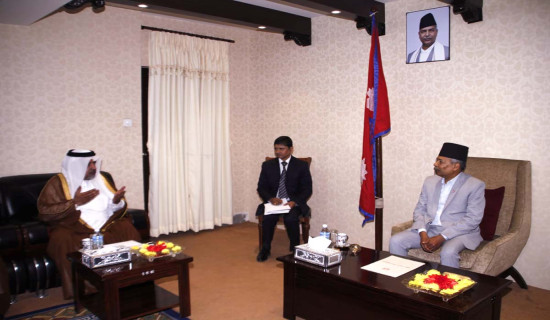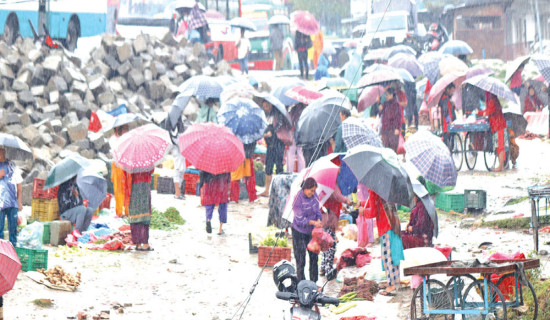- Wednesday, 10 December 2025
Gold price reaches all-time high
Kathmandu, Aug. 30:The price of gold reached a record high of Rs. 200,600 per tola in the domestic bullion market.
According to the Federation of Nepal Gold and Silver Dealers’ Association (FENEGOSIDA), the price rose by Rs. 1,200 per tola, increasing from Rs. 199,400 per tola on Thursday to Rs. 200,600 per tola on Friday. The surge is attributed to rising gold prices in the international market and the depreciation of the Nepali rupee against the US dollar.
Earlier, the gold price set a record on August 8, when it was traded at Rs. 199,400 per tola. Similarly, silver's price also set a record in the local market on Friday. It was traded at Rs. 2,360 per tola. “The increase in the gold price in the international market and devaluation of Nepali currency against the US dollar are the main reasons for the high gold price in the local market,” said Tej Ratna Shakya, a gold trader.
The price of gold increased by USD 20 per ounce and reached USD 3,410 per ounce in the international market on Friday, he said.
"Surprisingly, gold was traded at around Rs. 198,000 per tola in the local market in April this year when its international price was about USD 3,500 per ounce. Today's price indicates that the rupee’s fall has had a compounding effect on domestic prices," he said. The Nepali rupee has become weak, with the exchange rate of 1 USD standing at Rs. 140.51 on Friday. Gold prices in the local market have more than doubled in the past three years.
In April 2022, gold first crossed the Rs. 100,000 per tola threshold. However, the steep price rise has led to a consistent decline in domestic demand for gold, according to traders.
He said that the price of gold has been skyrocketing in the international market due to the global political unrest and the new steps taken by US President Donald Trump.
He said that the main reason for the increase in gold prices in the international market is the rumours that the Federal Reserve Bank of the United States of America is cutting interest rates from September. "Fearing that the Federal Reserve Bank of the US will cut interest rates, the investors are encouraged to invest in gold, leading to increased demand for gold and its prices as well," said Shakya.
Demand for gold is almost nil, financial burden
The demand for gold in the domestic market has dropped sharply, with traders reporting almost negligible sales in recent weeks. Shakya attributed this dramatic decline to the soaring price of gold, coupled with the recent imposition of a luxury tax .
Speaking on the matter, Shakya noted that the market has been severely impacted by both economic and policy factors. "On the one hand, gold prices have skyrocketed, and on the other, the government has imposed a 2 per cent luxury tax on gold purchases. In this context, consumers are simply not interested in buying gold,” he said.
The recent surge in gold prices is placing an additional financial burden on consumers, particularly during the peak wedding season and upcoming religious festivals.
Tek Nath Adhikari, a resident of Gatthaghar, Bhaktapur, expressed concern over how the escalating cost of gold is adding a significant burden to traditional wedding expenses.
“Gold is an essential part of our wedding culture, and with the price rising so sharply, it's becoming harder for middle-class families to afford,” Adhikari said. “It’s not just about ornaments—it’s about fulfilling cultural expectations and family traditions.” Traditionally seen as a symbol of wealth and prosperity, gold plays a central role in Nepali weddings and religious ceremonies, with families often investing heavily in jewelry and ornaments.
Over the past years, gold prices have seen a significant rise due to global economic uncertainties, inflationary pressures, and strong international demand. As a result, many families are now forced to reassess their budgets or cut back on the scale of planned celebrations.
Shakya further revealed that even during the recent Teej festival, which traditionally sees a surge in gold sales, the demand remained nominal. "Just two years ago, up to 45 kilograms of gold were sold daily during Teej. This year, that figure has dwindled drastically," he added.
He said that continued low demand could affect the entire bullion market, from importers to small-scale retailers, and called on the government to reconsider the luxury tax to revive the sector. Due to the price hike, the demand for gold is expected to see a notable decline in the upcoming Dashain and Tihar festivals, he added.







-square-thumb.jpg)



-original-thumb.jpg)

-original-thumb.jpg)

